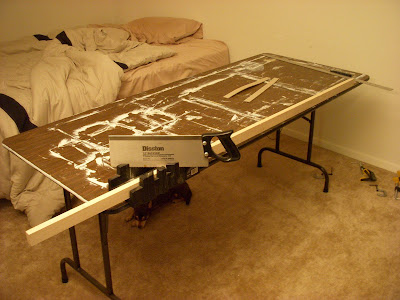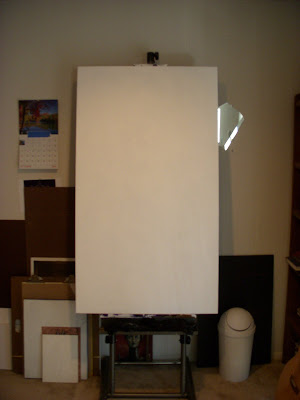This month I'll be going through the whole painting process, from surface construction to finished painting, to help those who want to know how to do it, and for those who are just curious what goes into making your surface from about as close to scratch as you can get with out growing the trees yourself.
 Here you have a sheet of hardboard, it's also called Masonite, but that's the brand name not the product, the actual wood being called hardboard. Then the board you use to cradle with is poplar, I prefer this over pine, from what I've been told pine has a greater chance of warping over time.
Here you have a sheet of hardboard, it's also called Masonite, but that's the brand name not the product, the actual wood being called hardboard. Then the board you use to cradle with is poplar, I prefer this over pine, from what I've been told pine has a greater chance of warping over time.
 Cut the size you need to go around the inside area of the hardboard from the poplar, making a 45 degree angle cut on both ends. The longest end of the cut, where it tapers off, should be the length of your board. So if your board is 16x20, cut your poplar to 16 and 20 inch cuts, don't over compensate for the outside edge, because these are cradling the hardboard, not framing it.
Cut the size you need to go around the inside area of the hardboard from the poplar, making a 45 degree angle cut on both ends. The longest end of the cut, where it tapers off, should be the length of your board. So if your board is 16x20, cut your poplar to 16 and 20 inch cuts, don't over compensate for the outside edge, because these are cradling the hardboard, not framing it. Using wood glue and vice grips ( and if your cheap like me weights cause you didn't have enough vice grips) set the poplar pieces to the edge of the hard board, making the two woods flush with one another to make a smooth edge. This should set for at least 30min, or even longer if you want to make sure you have a tight fit. Don't stress newly glued joints for 24hrs after gluing.
Using wood glue and vice grips ( and if your cheap like me weights cause you didn't have enough vice grips) set the poplar pieces to the edge of the hard board, making the two woods flush with one another to make a smooth edge. This should set for at least 30min, or even longer if you want to make sure you have a tight fit. Don't stress newly glued joints for 24hrs after gluing. Your corners should look like this if you did the 45 degree angle. You can also elbow joint it if you want, not sure if either is better structural makeup, I just prefer the look of the 45 degree angle fit.
Your corners should look like this if you did the 45 degree angle. You can also elbow joint it if you want, not sure if either is better structural makeup, I just prefer the look of the 45 degree angle fit. Just continue to glue the poplar down to the edge of the board to make a flat edge, try your best to get no hang over of the poplar or hardboard.
Just continue to glue the poplar down to the edge of the board to make a flat edge, try your best to get no hang over of the poplar or hardboard. The finished cradle with a cross bar. Right now time and money wont permit, but I think from now on just for looks and better structure I'm going to start putting in corner bars too. People may never see this side of your painting, but it's still important to me to have good craftsmanship and aesthetics. This is only my 2nd cradled board so there's always room for improvement, corner bars next time!
The finished cradle with a cross bar. Right now time and money wont permit, but I think from now on just for looks and better structure I'm going to start putting in corner bars too. People may never see this side of your painting, but it's still important to me to have good craftsmanship and aesthetics. This is only my 2nd cradled board so there's always room for improvement, corner bars next time! Now we begin prepping the board. First thing, tape off the edge of your cradle to protect from the dripping of all the paint, polymer, and materials you'll be using. This will give you a nice clean edge on your board.
Now we begin prepping the board. First thing, tape off the edge of your cradle to protect from the dripping of all the paint, polymer, and materials you'll be using. This will give you a nice clean edge on your board. Now apply GAC 100 from golden. This helps keep the hardboard from damaging the paint after your finished. A lot of hardboard comes tempered with chemicals that can eventually damage and seep into your painting over time, causing discoloring. I do two coats to make sure the surface is well and sealed.
Now apply GAC 100 from golden. This helps keep the hardboard from damaging the paint after your finished. A lot of hardboard comes tempered with chemicals that can eventually damage and seep into your painting over time, causing discoloring. I do two coats to make sure the surface is well and sealed. Now go back in with another polymer medium to seal off the edges of the tape more, here I'm using regular gel gloss from Golden. This will help do the same thing the tape will do, but in my experience I've had oil washes seep down between the cradle and tape, so here I do this to help protect against thin downed materials that will sometimes breach the tape.
Now go back in with another polymer medium to seal off the edges of the tape more, here I'm using regular gel gloss from Golden. This will help do the same thing the tape will do, but in my experience I've had oil washes seep down between the cradle and tape, so here I do this to help protect against thin downed materials that will sometimes breach the tape. Finally we get to gesso the board. Here I apply 3 to 4 coats to cover up and color of the hardboard and to make a solid surface barrier between the board and the paint. This will help with adhesion of the paint and a more archival surface for the paint to rest on.
Finally we get to gesso the board. Here I apply 3 to 4 coats to cover up and color of the hardboard and to make a solid surface barrier between the board and the paint. This will help with adhesion of the paint and a more archival surface for the paint to rest on.
Should have enough coats of gesso so that areas like these don't show any of the hardboard underneath. Go for completely white.

Board finished and ready to paint on. I'll add my steps of painting as I get this guy done over the next 3 weeks. Peace.
